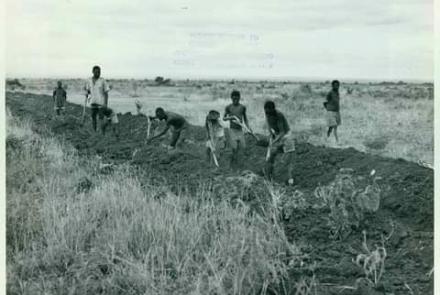Life After School
After leaving school Kenyatta approached John Cook, an engineer who came to East Africa in December 1907 as one of Henry Scott’s party to take charge of a new building programme. In 1916, he was working as the manager of a sisal company in Thika and it was then that Kenyatta joined him there. Cook liked him and entrusted him with the job of fetching the company wages from the bank in Nairobi, 25 miles away. He was earning Shs250 per month, a princely sum at the time. But at this time the trouble with his lungs flared up again and he fell seriously ill. He decided not to return to Thogoto for treatment, but instead opted for the Presbyterian mission hospital at Tumu Tumu, where he had a friend, Charles Kasaja.
By this time, the Mission was required by London to support the Empire with its war effort. So Arthur proposed forming a special contingent of volunteer porters from among the missionaries themselves. Most of Kenyatta’s generation at Thogoto enrolled; Philip Karanja and Musa Gitau were among the leaders. Charles Kasaja volunteered but was asked by Dr Arthur to remain at Thogoto as his interpreter and assistant. But Kenyatta was not involved; it’s presumed that John Cook sheltered him for a while. Though the Kikuyu and the Maasai were traditional enemies, certain clans among both tribes had long maintained contact with each other. Kenyatta’s family had these connections. One of his grandfather’s wives was a Maasai woman and he also had an aunt married to a Maasai chief; so he took this opportunity, knowing the safest place to avoid recruitment was in Maasailand.
Hence it was in Narok that Kenyatta found himself in 1917, possibly with Indians acting as agents for army contractors. It was here that he bought a beaded belt which the Maasai called Kinyatta; he was later to adopt this name which became Kenyatta. At Narok, he worked as some kind of administrative clerk responsible for getting the cattle, sheep and donkeys through to Nairobi. Then at the beginning of 1918, the Kikuyu Mission Volunteers returned from Dar es Salaam. Hence the pressure on the Kikuyu relaxed, and Kenyatta left his retreat to return to Nairobi where jobs for educated and hardworking Africans were well paid. He attended evening classes and for a time worked for a certain Stephen Ellis, looking after a store that sold farming and engineering equipment. Some months later, Kenyatta was responsible for building houses for staff at the Thogoto mission. But it was Nairobi that attracted him and he rapidly adapted to the new style of life in the city.
On returning from Maasailand, Kenyatta reconnected with his stepfather at Ngenda. He had not forgotten his own family lands for which he, as the eldest surviving son of Muigai, would inherit. Kenyatta had the right to ask Ngengi for the sheep and goats for each stage in his tribal life; obtaining a wife was an important step for the young Kikuyu men. Kenyatta’s first bid for a wife failed as she turned out to be related to his own clan. He soon found another girl, Grace Wahu, who was attending the Christian Mission School for Girls at Kabete, not far from Dagoreti. He settled her on the family homestead and on 20th November 1920, his first child, a boy, was born and named after his father Muigai.
Ngengi was not easy to live with; the old man resented the growing sons of his dead brother. He also grew irritated by the presence of Grace and the new baby, so he resorted to the traditional Kikuyu device for getting rid of people, which was to cut another door into her hut; it was a form of curse and no one could endure the disgrace of it without moving, so Grace took the baby to join Kenyatta at Dagoreti, where he lived for some time in Kioi’s village. Kioi was among the biggest land owners of the district around the Presbyterian mission. He was a descendant of Waiyaki and Kenyatta, as one who knew his way around the mission and had experienced the white man’s way in Nairobi, was a useful retainer to such a chief. Hence he called upon Kenyatta to help him in a land case that came up in 1919. In a previous action, the judge had ordered Kioi to remove his huts from a certain piece of land. He had obeyed and placed them on the land now in dispute. The plaintiffs claimed that their father had bought this land from the Ndorobo, while Kioi countered by saying the initial owner of the land was Kinyanjui and that he had bought the land from him for a hundred goats, four oxen, one daughter and four fat sheep. This was a story of complex family relationships and Kenyatta’s role was to explain to Kioi’s European lawyers the precise meaning of these complex kinship ties. But Kioi lost, with the trial judge dismissing much of the evidence. The case raised the whole question of land ownership and threw into sharp contrast western legal concepts and immemorial tribal custom. In 1921, the colony’s Chief Justice drew upon the Kioi case in delivering a later judgment: that the only real owner of land reserved for use by tribes was the Crown; it made explicit that the colonial power was absolute and in consequence all native rights in such reserved land disappeared.


